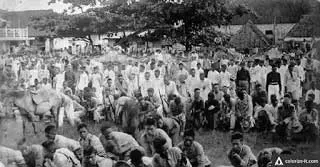Barrios in Lipa where Concentration Camps were set up during the Fil-Am War
Most readers will recall from secondary History textbooks that Batangas was the last province to drop its resistance to United States forces in what is known as the Philippine-American War. “Batangas” was, in fact, a region composed of the provinces of Batangas, Laguna and Tayabas (presently Quezon Province) which American military planners referred to collectively as “Batangas region” or as “Southern Luzon1.”
To put an end to the war. Major General Adna Chaffee, United States Military Governor of the Philippines2, sent to the region Brigadier General James Franklin Bell. The latter’s solution to what the Americans called the “insurgency” problem was to separate the so-called “rebels” from the civilians by forcing the latter to move into concentration camps.
“In order to put an end to enforced contributions, now levied by insurgents upon the inhabitants of sparsely settled an outlying barrios and districts… will immediately specify and establish plainly marked limited surrounding each town bounding a zone… with an average size garrison, to exercise supervision over and furnish protection to inhabitants (who desire to be peaceful) against the depredations of armed insurgents… Commanding officers will also see that orders are at once given and distributed to all the inhabitants within the jurisdiction of town… that unless they move by December 25th from outlying barrios and districts with all their movable food supplies… to within the limits of the zone established at their own or nearest town, their property (found outside of said zone at said date) will become liable to confiscation or destruction3.”
Exactly where these concentration camps were set up in each town has been mostly obscured by time. Most of the so-called barrio “historical data” of the different cities and municipalities of Batangas have passing references to these camps, but those for Lipa City identify at least two and possibly three actual locations.
There are historians who scoff at the veracity of these so-called “historical data,” since many of these documents were poorly researched and often reliant on the recollections of the elderly. However, even if so, a 15-year old in 1901 when the concentration camp policy came into effect would have been in his late sixties when the “historical data” were collected; so recollections would not have been totally without merit.
From the “historical data” for the barrio of Bulacnin north of poblacion Lipa City, we obtain information that there was a concentration camp set up in barrio Tanguay (presently spelled Tangway), just north of Bulacnin. The date provided was October 1911 and obviously erroneous, time obviously having played tricks on the minds of the elderly sources; but the description of the event was remarkably consistent with other historical accounts:
“The people, together with their personal belongings, work animals and everything that they could carry, were forced to leave their homes and were zoned in the vicinity of Tanguay. Practically nothing was left in the barrio. The “insurrectos” who were left behind had nothing for food. Thinking that they had been betrayed by their countrymen, the irate rebels burned some of the houses. When the Americans learned of this, they knew that there were still some people who remained behind, so they set fire to the houses and properties that they could find so that nobody would benefit from anything left there, including the sources of food supply4.”
“To safeguard the lives of the people and to facilitate the work in mopping operations against those Filipinos who did not yet recognize the sovereignty of the United States in the Philippines, the American Forces who were stationed in Lipa during the period enforced the so-called “Zona.” The people of Cumba, together with those of the neighboring barrios in the southern part of Lipa, were assembled in the barrio of Bolbok. This was in the year 1901. During this period of zonification, the people suffered many hardships. Their properties were destroyed, some houses were burned, and many people died as a result of the cholera epidemic that followed5.”
The unsanitary conditions in these concentration camps were covered up by American military authorities who insisted that conditions in the camp were “humane.” However, the American historical Glenn Anthony May, digging deep, concluded that food shortages and the unsanitary conditions in cramped conditions were perfect for diseases to thrive6.
Another concentration camp was likely set up in the barrio of Latag, very close to poblacion Lipa City. Unfortunately, the information given by the “historical data” for the barrio was extremely limited:
“Latag was zoned by the Americans. Barrio folks could not go out for they were restricted in the zoning area7.”
2 “Adna Chaffee,” Wikipedia.
3 Michael, op. cit. p. 86.
4 “The History of Bulacnin,” online at the National Library of the Philippines Digital Collections.
5 “The History and Cultural Life of the Barrio of Cumba,” online at the National Library of the Philippines Digital Collections.
6 “The Zones of Batangas,” by Glen A. May, published in “The Philippine Studies,” 1981.
7 “The Barrio of Latag,” online at the National Library of the Philippines Digital Collections.

